Leadership Analysis: Business Ethics in Bottle Shock Exercise Report
VerifiedAdded on 2020/05/11
|13
|3625
|112
Report
AI Summary
This report analyzes a business ethics case study, focusing on the 'Bottle Shock' exercise. It explores the roles and responsibilities of a business leader, emphasizing the importance of creating a vision, humanizing the business, providing constant motivation, and fostering team development. The report evaluates the student's leadership performance within the exercise, assessing time management, communication, and the ability to handle customer complaints. It also discusses areas for improvement, such as enhancing time management skills, promoting effective communication, and developing a leadership approach that considers both employee and customer needs. The analysis highlights the significance of a participative leadership style and the impact of a leader's personality on consumer behavior, ultimately providing recommendations for becoming a more effective and ethical leader.
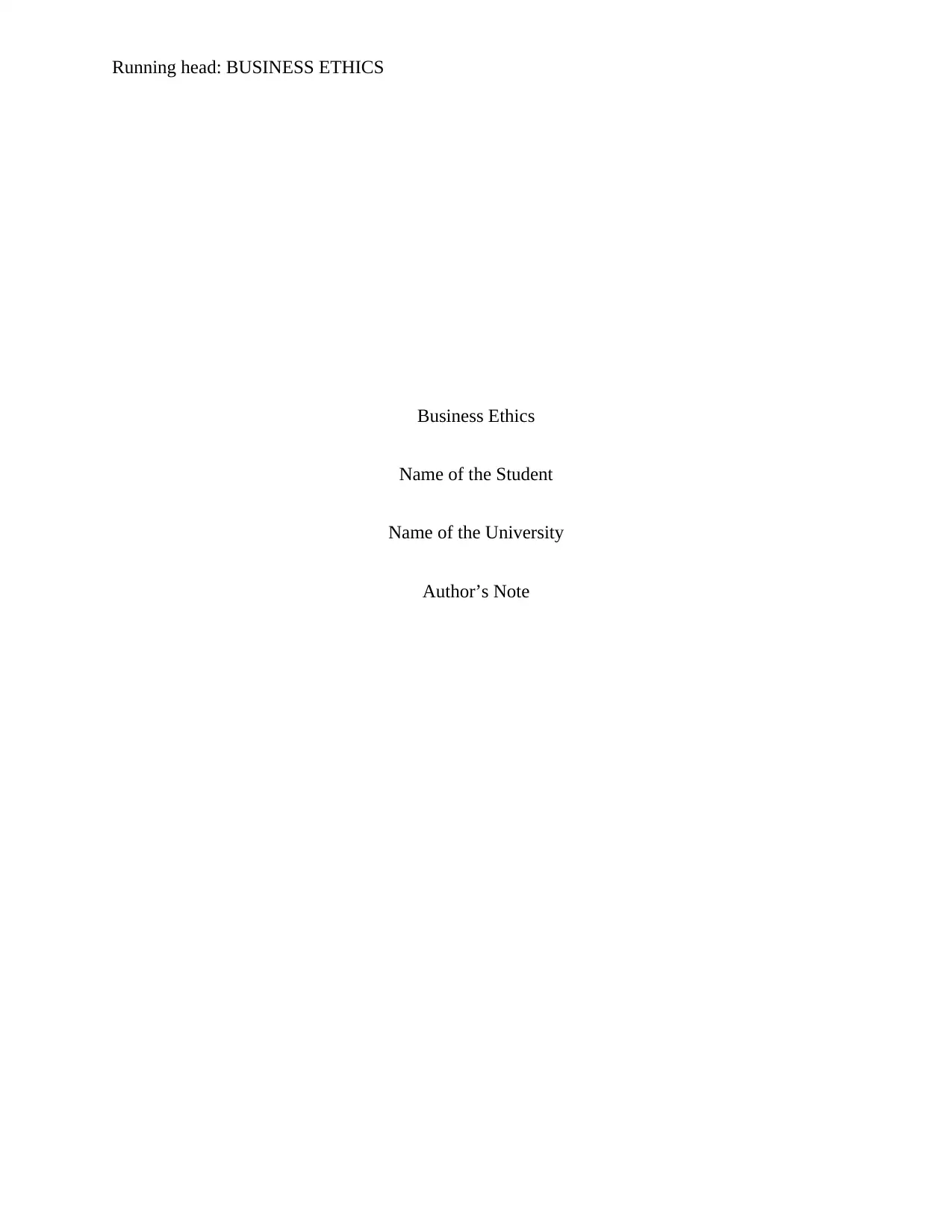
Running head: BUSINESS ETHICS
Business Ethics
Name of the Student
Name of the University
Author’s Note
Business Ethics
Name of the Student
Name of the University
Author’s Note
Paraphrase This Document
Need a fresh take? Get an instant paraphrase of this document with our AI Paraphraser
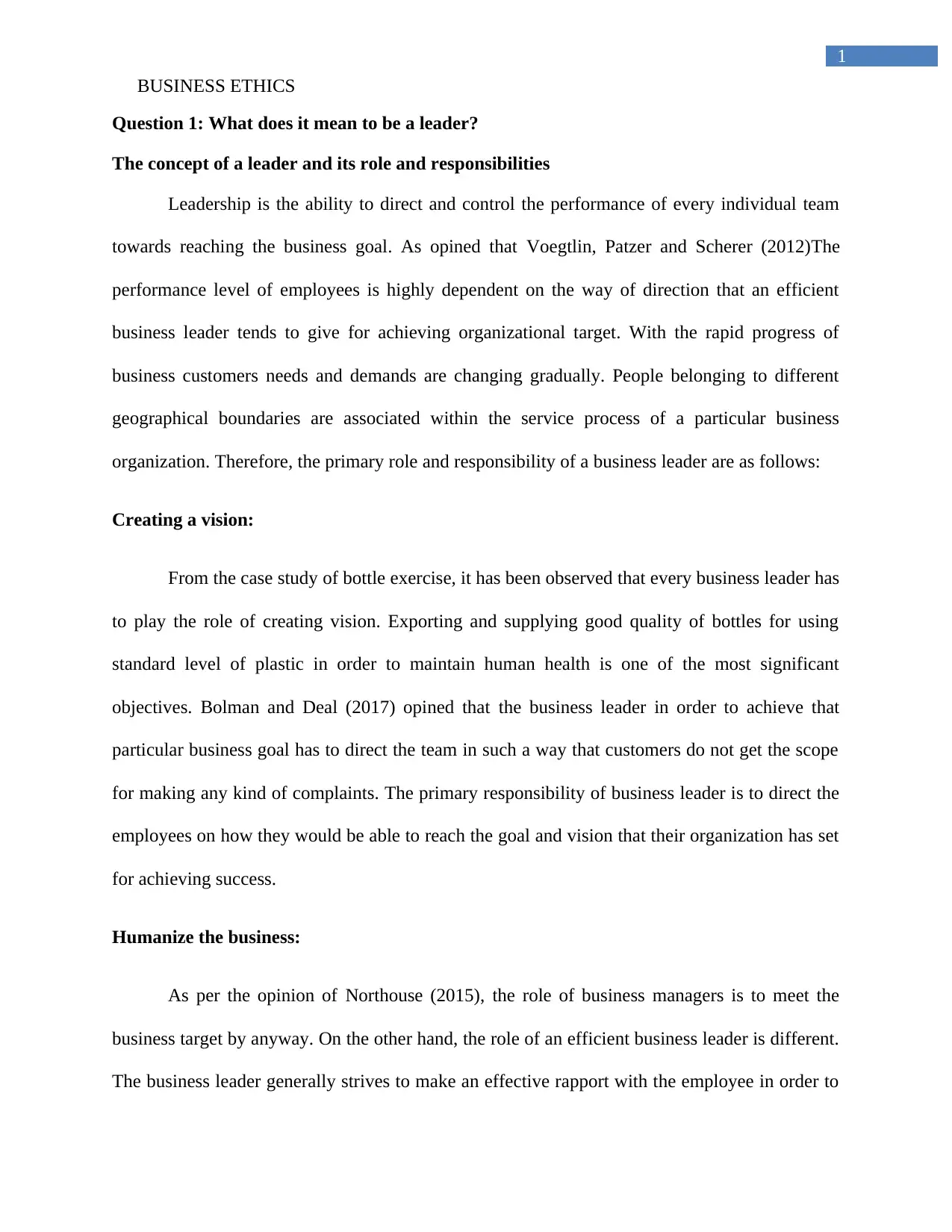
1
BUSINESS ETHICS
Question 1: What does it mean to be a leader?
The concept of a leader and its role and responsibilities
Leadership is the ability to direct and control the performance of every individual team
towards reaching the business goal. As opined that Voegtlin, Patzer and Scherer (2012)The
performance level of employees is highly dependent on the way of direction that an efficient
business leader tends to give for achieving organizational target. With the rapid progress of
business customers needs and demands are changing gradually. People belonging to different
geographical boundaries are associated within the service process of a particular business
organization. Therefore, the primary role and responsibility of a business leader are as follows:
Creating a vision:
From the case study of bottle exercise, it has been observed that every business leader has
to play the role of creating vision. Exporting and supplying good quality of bottles for using
standard level of plastic in order to maintain human health is one of the most significant
objectives. Bolman and Deal (2017) opined that the business leader in order to achieve that
particular business goal has to direct the team in such a way that customers do not get the scope
for making any kind of complaints. The primary responsibility of business leader is to direct the
employees on how they would be able to reach the goal and vision that their organization has set
for achieving success.
Humanize the business:
As per the opinion of Northouse (2015), the role of business managers is to meet the
business target by anyway. On the other hand, the role of an efficient business leader is different.
The business leader generally strives to make an effective rapport with the employee in order to
BUSINESS ETHICS
Question 1: What does it mean to be a leader?
The concept of a leader and its role and responsibilities
Leadership is the ability to direct and control the performance of every individual team
towards reaching the business goal. As opined that Voegtlin, Patzer and Scherer (2012)The
performance level of employees is highly dependent on the way of direction that an efficient
business leader tends to give for achieving organizational target. With the rapid progress of
business customers needs and demands are changing gradually. People belonging to different
geographical boundaries are associated within the service process of a particular business
organization. Therefore, the primary role and responsibility of a business leader are as follows:
Creating a vision:
From the case study of bottle exercise, it has been observed that every business leader has
to play the role of creating vision. Exporting and supplying good quality of bottles for using
standard level of plastic in order to maintain human health is one of the most significant
objectives. Bolman and Deal (2017) opined that the business leader in order to achieve that
particular business goal has to direct the team in such a way that customers do not get the scope
for making any kind of complaints. The primary responsibility of business leader is to direct the
employees on how they would be able to reach the goal and vision that their organization has set
for achieving success.
Humanize the business:
As per the opinion of Northouse (2015), the role of business managers is to meet the
business target by anyway. On the other hand, the role of an efficient business leader is different.
The business leader generally strives to make an effective rapport with the employee in order to
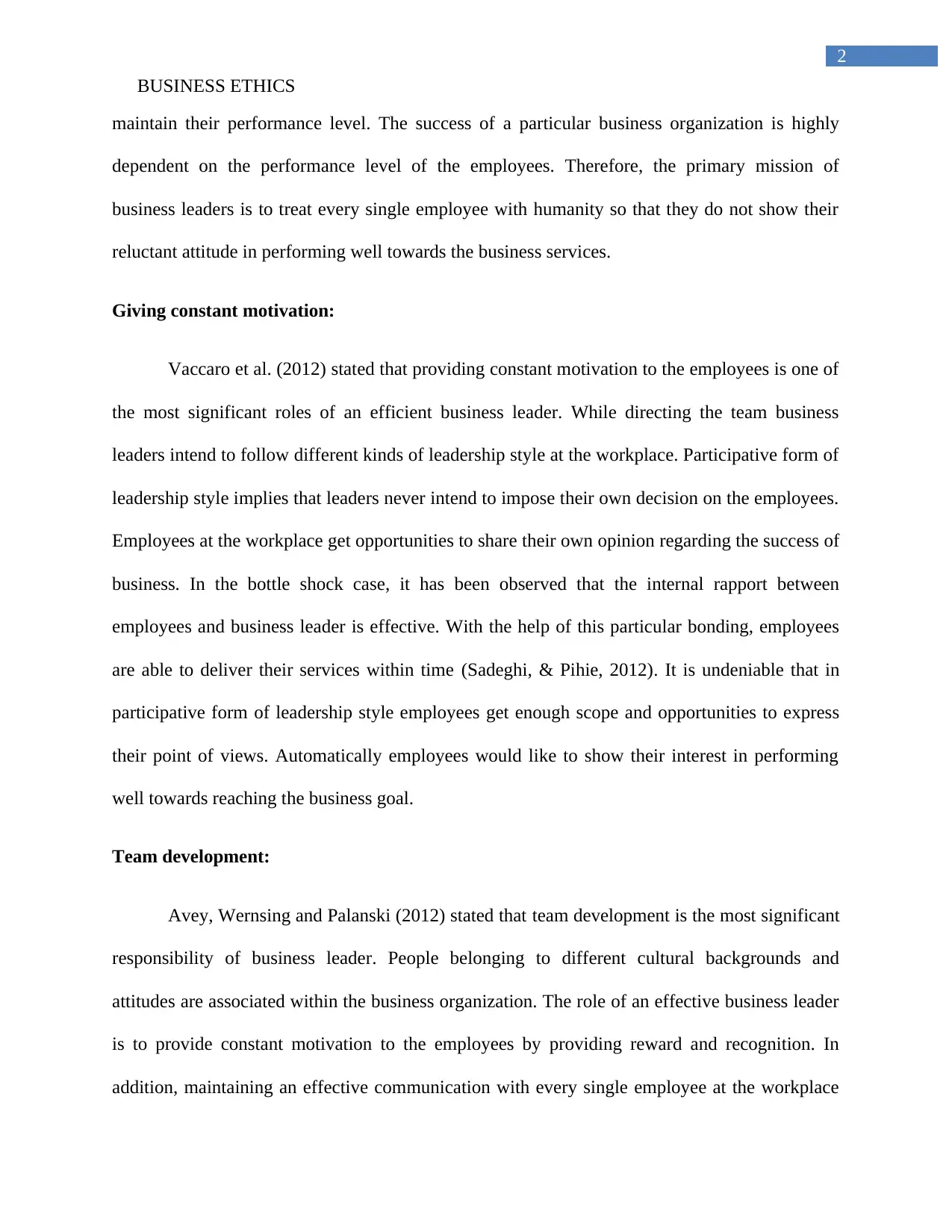
2
BUSINESS ETHICS
maintain their performance level. The success of a particular business organization is highly
dependent on the performance level of the employees. Therefore, the primary mission of
business leaders is to treat every single employee with humanity so that they do not show their
reluctant attitude in performing well towards the business services.
Giving constant motivation:
Vaccaro et al. (2012) stated that providing constant motivation to the employees is one of
the most significant roles of an efficient business leader. While directing the team business
leaders intend to follow different kinds of leadership style at the workplace. Participative form of
leadership style implies that leaders never intend to impose their own decision on the employees.
Employees at the workplace get opportunities to share their own opinion regarding the success of
business. In the bottle shock case, it has been observed that the internal rapport between
employees and business leader is effective. With the help of this particular bonding, employees
are able to deliver their services within time (Sadeghi, & Pihie, 2012). It is undeniable that in
participative form of leadership style employees get enough scope and opportunities to express
their point of views. Automatically employees would like to show their interest in performing
well towards reaching the business goal.
Team development:
Avey, Wernsing and Palanski (2012) stated that team development is the most significant
responsibility of business leader. People belonging to different cultural backgrounds and
attitudes are associated within the business organization. The role of an effective business leader
is to provide constant motivation to the employees by providing reward and recognition. In
addition, maintaining an effective communication with every single employee at the workplace
BUSINESS ETHICS
maintain their performance level. The success of a particular business organization is highly
dependent on the performance level of the employees. Therefore, the primary mission of
business leaders is to treat every single employee with humanity so that they do not show their
reluctant attitude in performing well towards the business services.
Giving constant motivation:
Vaccaro et al. (2012) stated that providing constant motivation to the employees is one of
the most significant roles of an efficient business leader. While directing the team business
leaders intend to follow different kinds of leadership style at the workplace. Participative form of
leadership style implies that leaders never intend to impose their own decision on the employees.
Employees at the workplace get opportunities to share their own opinion regarding the success of
business. In the bottle shock case, it has been observed that the internal rapport between
employees and business leader is effective. With the help of this particular bonding, employees
are able to deliver their services within time (Sadeghi, & Pihie, 2012). It is undeniable that in
participative form of leadership style employees get enough scope and opportunities to express
their point of views. Automatically employees would like to show their interest in performing
well towards reaching the business goal.
Team development:
Avey, Wernsing and Palanski (2012) stated that team development is the most significant
responsibility of business leader. People belonging to different cultural backgrounds and
attitudes are associated within the business organization. The role of an effective business leader
is to provide constant motivation to the employees by providing reward and recognition. In
addition, maintaining an effective communication with every single employee at the workplace
⊘ This is a preview!⊘
Do you want full access?
Subscribe today to unlock all pages.

Trusted by 1+ million students worldwide
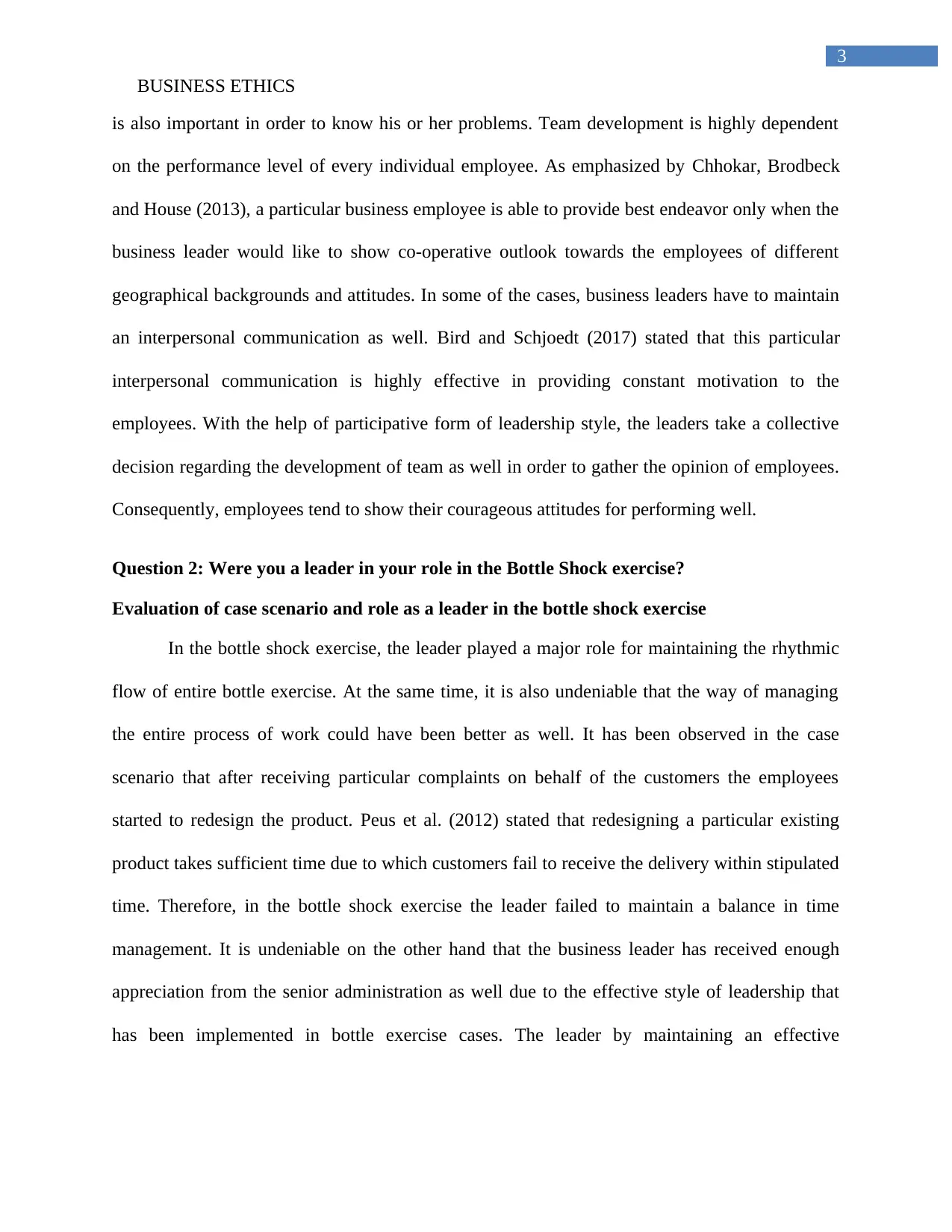
3
BUSINESS ETHICS
is also important in order to know his or her problems. Team development is highly dependent
on the performance level of every individual employee. As emphasized by Chhokar, Brodbeck
and House (2013), a particular business employee is able to provide best endeavor only when the
business leader would like to show co-operative outlook towards the employees of different
geographical backgrounds and attitudes. In some of the cases, business leaders have to maintain
an interpersonal communication as well. Bird and Schjoedt (2017) stated that this particular
interpersonal communication is highly effective in providing constant motivation to the
employees. With the help of participative form of leadership style, the leaders take a collective
decision regarding the development of team as well in order to gather the opinion of employees.
Consequently, employees tend to show their courageous attitudes for performing well.
Question 2: Were you a leader in your role in the Bottle Shock exercise?
Evaluation of case scenario and role as a leader in the bottle shock exercise
In the bottle shock exercise, the leader played a major role for maintaining the rhythmic
flow of entire bottle exercise. At the same time, it is also undeniable that the way of managing
the entire process of work could have been better as well. It has been observed in the case
scenario that after receiving particular complaints on behalf of the customers the employees
started to redesign the product. Peus et al. (2012) stated that redesigning a particular existing
product takes sufficient time due to which customers fail to receive the delivery within stipulated
time. Therefore, in the bottle shock exercise the leader failed to maintain a balance in time
management. It is undeniable on the other hand that the business leader has received enough
appreciation from the senior administration as well due to the effective style of leadership that
has been implemented in bottle exercise cases. The leader by maintaining an effective
BUSINESS ETHICS
is also important in order to know his or her problems. Team development is highly dependent
on the performance level of every individual employee. As emphasized by Chhokar, Brodbeck
and House (2013), a particular business employee is able to provide best endeavor only when the
business leader would like to show co-operative outlook towards the employees of different
geographical backgrounds and attitudes. In some of the cases, business leaders have to maintain
an interpersonal communication as well. Bird and Schjoedt (2017) stated that this particular
interpersonal communication is highly effective in providing constant motivation to the
employees. With the help of participative form of leadership style, the leaders take a collective
decision regarding the development of team as well in order to gather the opinion of employees.
Consequently, employees tend to show their courageous attitudes for performing well.
Question 2: Were you a leader in your role in the Bottle Shock exercise?
Evaluation of case scenario and role as a leader in the bottle shock exercise
In the bottle shock exercise, the leader played a major role for maintaining the rhythmic
flow of entire bottle exercise. At the same time, it is also undeniable that the way of managing
the entire process of work could have been better as well. It has been observed in the case
scenario that after receiving particular complaints on behalf of the customers the employees
started to redesign the product. Peus et al. (2012) stated that redesigning a particular existing
product takes sufficient time due to which customers fail to receive the delivery within stipulated
time. Therefore, in the bottle shock exercise the leader failed to maintain a balance in time
management. It is undeniable on the other hand that the business leader has received enough
appreciation from the senior administration as well due to the effective style of leadership that
has been implemented in bottle exercise cases. The leader by maintaining an effective
Paraphrase This Document
Need a fresh take? Get an instant paraphrase of this document with our AI Paraphraser
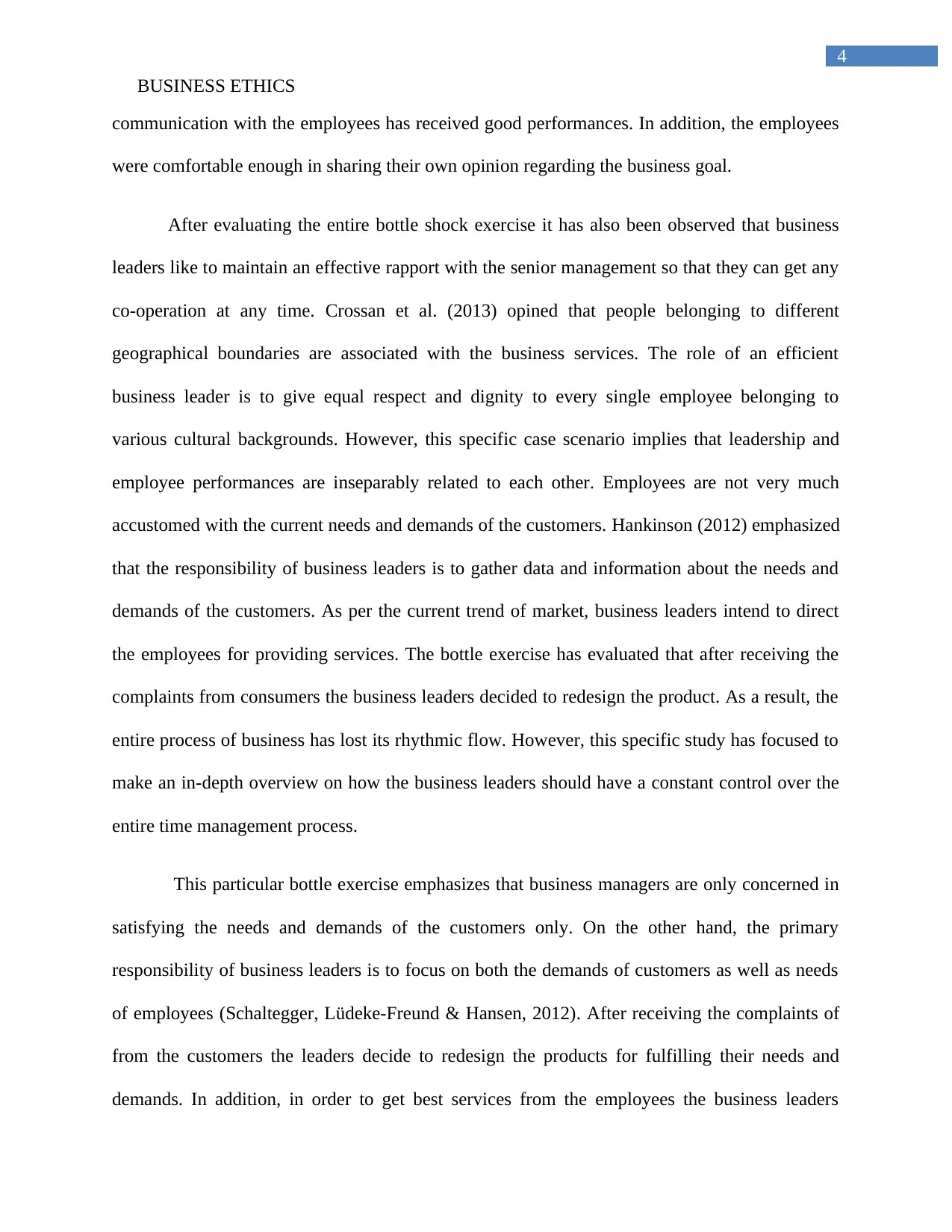
4
BUSINESS ETHICS
communication with the employees has received good performances. In addition, the employees
were comfortable enough in sharing their own opinion regarding the business goal.
After evaluating the entire bottle shock exercise it has also been observed that business
leaders like to maintain an effective rapport with the senior management so that they can get any
co-operation at any time. Crossan et al. (2013) opined that people belonging to different
geographical boundaries are associated with the business services. The role of an efficient
business leader is to give equal respect and dignity to every single employee belonging to
various cultural backgrounds. However, this specific case scenario implies that leadership and
employee performances are inseparably related to each other. Employees are not very much
accustomed with the current needs and demands of the customers. Hankinson (2012) emphasized
that the responsibility of business leaders is to gather data and information about the needs and
demands of the customers. As per the current trend of market, business leaders intend to direct
the employees for providing services. The bottle exercise has evaluated that after receiving the
complaints from consumers the business leaders decided to redesign the product. As a result, the
entire process of business has lost its rhythmic flow. However, this specific study has focused to
make an in-depth overview on how the business leaders should have a constant control over the
entire time management process.
This particular bottle exercise emphasizes that business managers are only concerned in
satisfying the needs and demands of the customers only. On the other hand, the primary
responsibility of business leaders is to focus on both the demands of customers as well as needs
of employees (Schaltegger, Lüdeke-Freund & Hansen, 2012). After receiving the complaints of
from the customers the leaders decide to redesign the products for fulfilling their needs and
demands. In addition, in order to get best services from the employees the business leaders
BUSINESS ETHICS
communication with the employees has received good performances. In addition, the employees
were comfortable enough in sharing their own opinion regarding the business goal.
After evaluating the entire bottle shock exercise it has also been observed that business
leaders like to maintain an effective rapport with the senior management so that they can get any
co-operation at any time. Crossan et al. (2013) opined that people belonging to different
geographical boundaries are associated with the business services. The role of an efficient
business leader is to give equal respect and dignity to every single employee belonging to
various cultural backgrounds. However, this specific case scenario implies that leadership and
employee performances are inseparably related to each other. Employees are not very much
accustomed with the current needs and demands of the customers. Hankinson (2012) emphasized
that the responsibility of business leaders is to gather data and information about the needs and
demands of the customers. As per the current trend of market, business leaders intend to direct
the employees for providing services. The bottle exercise has evaluated that after receiving the
complaints from consumers the business leaders decided to redesign the product. As a result, the
entire process of business has lost its rhythmic flow. However, this specific study has focused to
make an in-depth overview on how the business leaders should have a constant control over the
entire time management process.
This particular bottle exercise emphasizes that business managers are only concerned in
satisfying the needs and demands of the customers only. On the other hand, the primary
responsibility of business leaders is to focus on both the demands of customers as well as needs
of employees (Schaltegger, Lüdeke-Freund & Hansen, 2012). After receiving the complaints of
from the customers the leaders decide to redesign the products for fulfilling their needs and
demands. In addition, in order to get best services from the employees the business leaders
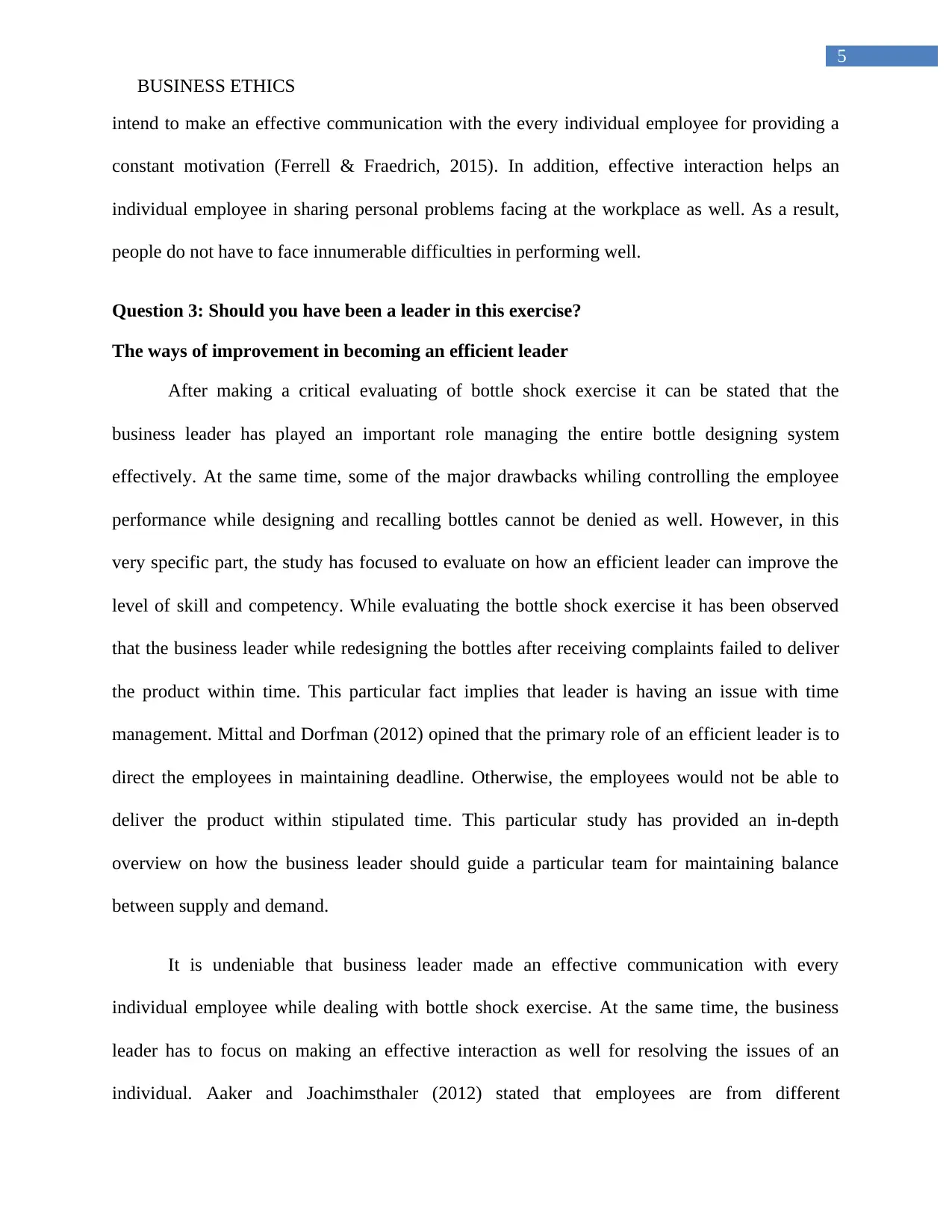
5
BUSINESS ETHICS
intend to make an effective communication with the every individual employee for providing a
constant motivation (Ferrell & Fraedrich, 2015). In addition, effective interaction helps an
individual employee in sharing personal problems facing at the workplace as well. As a result,
people do not have to face innumerable difficulties in performing well.
Question 3: Should you have been a leader in this exercise?
The ways of improvement in becoming an efficient leader
After making a critical evaluating of bottle shock exercise it can be stated that the
business leader has played an important role managing the entire bottle designing system
effectively. At the same time, some of the major drawbacks whiling controlling the employee
performance while designing and recalling bottles cannot be denied as well. However, in this
very specific part, the study has focused to evaluate on how an efficient leader can improve the
level of skill and competency. While evaluating the bottle shock exercise it has been observed
that the business leader while redesigning the bottles after receiving complaints failed to deliver
the product within time. This particular fact implies that leader is having an issue with time
management. Mittal and Dorfman (2012) opined that the primary role of an efficient leader is to
direct the employees in maintaining deadline. Otherwise, the employees would not be able to
deliver the product within stipulated time. This particular study has provided an in-depth
overview on how the business leader should guide a particular team for maintaining balance
between supply and demand.
It is undeniable that business leader made an effective communication with every
individual employee while dealing with bottle shock exercise. At the same time, the business
leader has to focus on making an effective interaction as well for resolving the issues of an
individual. Aaker and Joachimsthaler (2012) stated that employees are from different
BUSINESS ETHICS
intend to make an effective communication with the every individual employee for providing a
constant motivation (Ferrell & Fraedrich, 2015). In addition, effective interaction helps an
individual employee in sharing personal problems facing at the workplace as well. As a result,
people do not have to face innumerable difficulties in performing well.
Question 3: Should you have been a leader in this exercise?
The ways of improvement in becoming an efficient leader
After making a critical evaluating of bottle shock exercise it can be stated that the
business leader has played an important role managing the entire bottle designing system
effectively. At the same time, some of the major drawbacks whiling controlling the employee
performance while designing and recalling bottles cannot be denied as well. However, in this
very specific part, the study has focused to evaluate on how an efficient leader can improve the
level of skill and competency. While evaluating the bottle shock exercise it has been observed
that the business leader while redesigning the bottles after receiving complaints failed to deliver
the product within time. This particular fact implies that leader is having an issue with time
management. Mittal and Dorfman (2012) opined that the primary role of an efficient leader is to
direct the employees in maintaining deadline. Otherwise, the employees would not be able to
deliver the product within stipulated time. This particular study has provided an in-depth
overview on how the business leader should guide a particular team for maintaining balance
between supply and demand.
It is undeniable that business leader made an effective communication with every
individual employee while dealing with bottle shock exercise. At the same time, the business
leader has to focus on making an effective interaction as well for resolving the issues of an
individual. Aaker and Joachimsthaler (2012) stated that employees are from different
⊘ This is a preview!⊘
Do you want full access?
Subscribe today to unlock all pages.

Trusted by 1+ million students worldwide
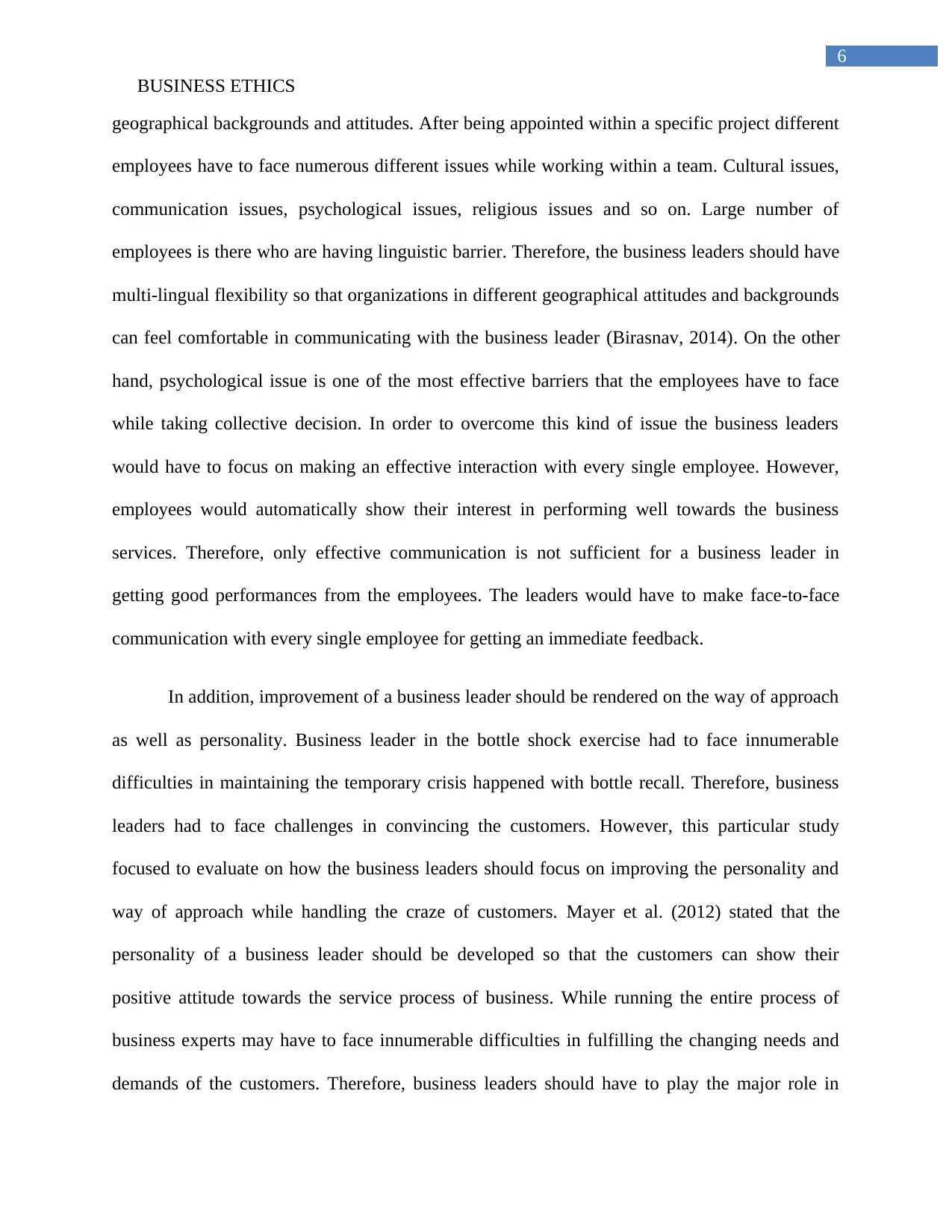
6
BUSINESS ETHICS
geographical backgrounds and attitudes. After being appointed within a specific project different
employees have to face numerous different issues while working within a team. Cultural issues,
communication issues, psychological issues, religious issues and so on. Large number of
employees is there who are having linguistic barrier. Therefore, the business leaders should have
multi-lingual flexibility so that organizations in different geographical attitudes and backgrounds
can feel comfortable in communicating with the business leader (Birasnav, 2014). On the other
hand, psychological issue is one of the most effective barriers that the employees have to face
while taking collective decision. In order to overcome this kind of issue the business leaders
would have to focus on making an effective interaction with every single employee. However,
employees would automatically show their interest in performing well towards the business
services. Therefore, only effective communication is not sufficient for a business leader in
getting good performances from the employees. The leaders would have to make face-to-face
communication with every single employee for getting an immediate feedback.
In addition, improvement of a business leader should be rendered on the way of approach
as well as personality. Business leader in the bottle shock exercise had to face innumerable
difficulties in maintaining the temporary crisis happened with bottle recall. Therefore, business
leaders had to face challenges in convincing the customers. However, this particular study
focused to evaluate on how the business leaders should focus on improving the personality and
way of approach while handling the craze of customers. Mayer et al. (2012) stated that the
personality of a business leader should be developed so that the customers can show their
positive attitude towards the service process of business. While running the entire process of
business experts may have to face innumerable difficulties in fulfilling the changing needs and
demands of the customers. Therefore, business leaders should have to play the major role in
BUSINESS ETHICS
geographical backgrounds and attitudes. After being appointed within a specific project different
employees have to face numerous different issues while working within a team. Cultural issues,
communication issues, psychological issues, religious issues and so on. Large number of
employees is there who are having linguistic barrier. Therefore, the business leaders should have
multi-lingual flexibility so that organizations in different geographical attitudes and backgrounds
can feel comfortable in communicating with the business leader (Birasnav, 2014). On the other
hand, psychological issue is one of the most effective barriers that the employees have to face
while taking collective decision. In order to overcome this kind of issue the business leaders
would have to focus on making an effective interaction with every single employee. However,
employees would automatically show their interest in performing well towards the business
services. Therefore, only effective communication is not sufficient for a business leader in
getting good performances from the employees. The leaders would have to make face-to-face
communication with every single employee for getting an immediate feedback.
In addition, improvement of a business leader should be rendered on the way of approach
as well as personality. Business leader in the bottle shock exercise had to face innumerable
difficulties in maintaining the temporary crisis happened with bottle recall. Therefore, business
leaders had to face challenges in convincing the customers. However, this particular study
focused to evaluate on how the business leaders should focus on improving the personality and
way of approach while handling the craze of customers. Mayer et al. (2012) stated that the
personality of a business leader should be developed so that the customers can show their
positive attitude towards the service process of business. While running the entire process of
business experts may have to face innumerable difficulties in fulfilling the changing needs and
demands of the customers. Therefore, business leaders should have to play the major role in
Paraphrase This Document
Need a fresh take? Get an instant paraphrase of this document with our AI Paraphraser
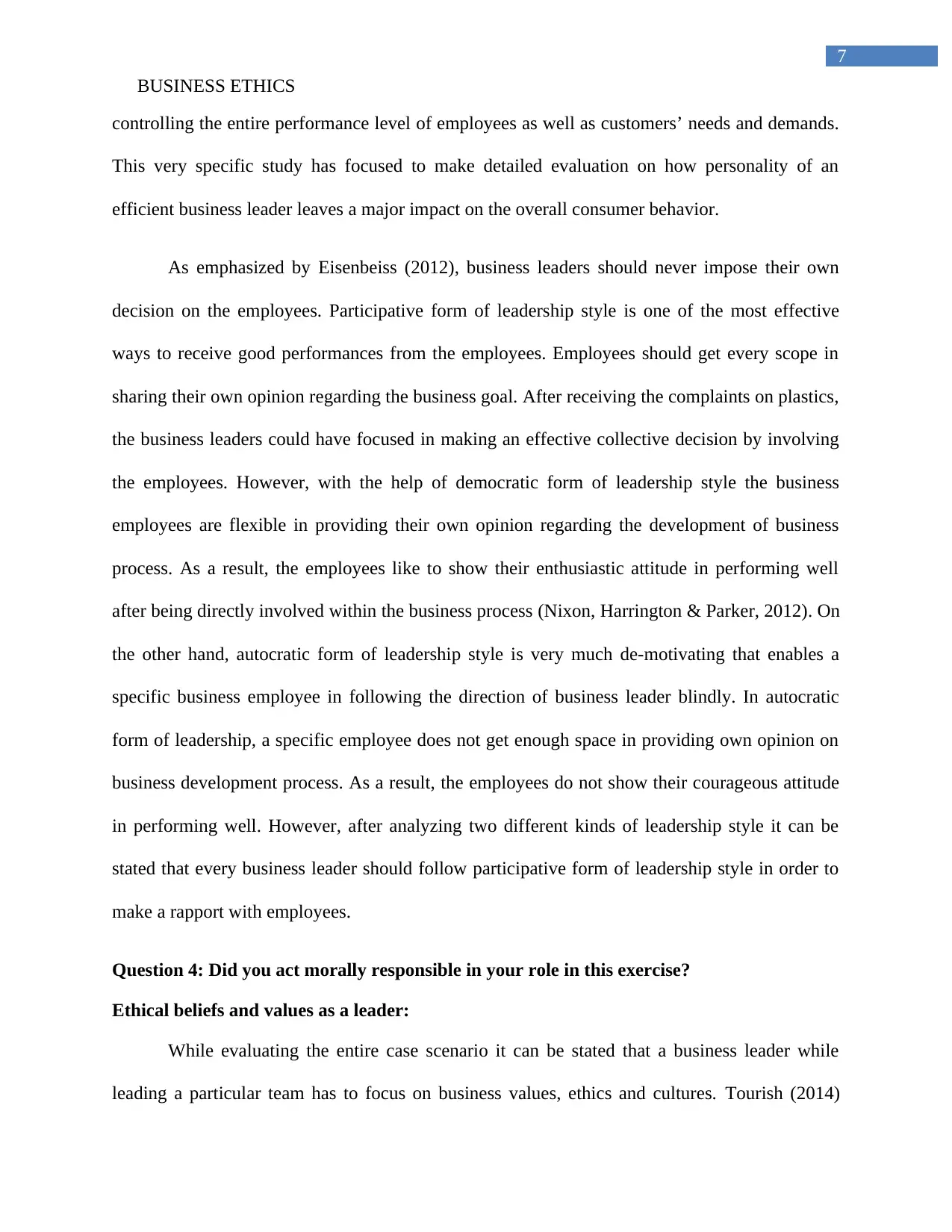
7
BUSINESS ETHICS
controlling the entire performance level of employees as well as customers’ needs and demands.
This very specific study has focused to make detailed evaluation on how personality of an
efficient business leader leaves a major impact on the overall consumer behavior.
As emphasized by Eisenbeiss (2012), business leaders should never impose their own
decision on the employees. Participative form of leadership style is one of the most effective
ways to receive good performances from the employees. Employees should get every scope in
sharing their own opinion regarding the business goal. After receiving the complaints on plastics,
the business leaders could have focused in making an effective collective decision by involving
the employees. However, with the help of democratic form of leadership style the business
employees are flexible in providing their own opinion regarding the development of business
process. As a result, the employees like to show their enthusiastic attitude in performing well
after being directly involved within the business process (Nixon, Harrington & Parker, 2012). On
the other hand, autocratic form of leadership style is very much de-motivating that enables a
specific business employee in following the direction of business leader blindly. In autocratic
form of leadership, a specific employee does not get enough space in providing own opinion on
business development process. As a result, the employees do not show their courageous attitude
in performing well. However, after analyzing two different kinds of leadership style it can be
stated that every business leader should follow participative form of leadership style in order to
make a rapport with employees.
Question 4: Did you act morally responsible in your role in this exercise?
Ethical beliefs and values as a leader:
While evaluating the entire case scenario it can be stated that a business leader while
leading a particular team has to focus on business values, ethics and cultures. Tourish (2014)
BUSINESS ETHICS
controlling the entire performance level of employees as well as customers’ needs and demands.
This very specific study has focused to make detailed evaluation on how personality of an
efficient business leader leaves a major impact on the overall consumer behavior.
As emphasized by Eisenbeiss (2012), business leaders should never impose their own
decision on the employees. Participative form of leadership style is one of the most effective
ways to receive good performances from the employees. Employees should get every scope in
sharing their own opinion regarding the business goal. After receiving the complaints on plastics,
the business leaders could have focused in making an effective collective decision by involving
the employees. However, with the help of democratic form of leadership style the business
employees are flexible in providing their own opinion regarding the development of business
process. As a result, the employees like to show their enthusiastic attitude in performing well
after being directly involved within the business process (Nixon, Harrington & Parker, 2012). On
the other hand, autocratic form of leadership style is very much de-motivating that enables a
specific business employee in following the direction of business leader blindly. In autocratic
form of leadership, a specific employee does not get enough space in providing own opinion on
business development process. As a result, the employees do not show their courageous attitude
in performing well. However, after analyzing two different kinds of leadership style it can be
stated that every business leader should follow participative form of leadership style in order to
make a rapport with employees.
Question 4: Did you act morally responsible in your role in this exercise?
Ethical beliefs and values as a leader:
While evaluating the entire case scenario it can be stated that a business leader while
leading a particular team has to focus on business values, ethics and cultures. Tourish (2014)
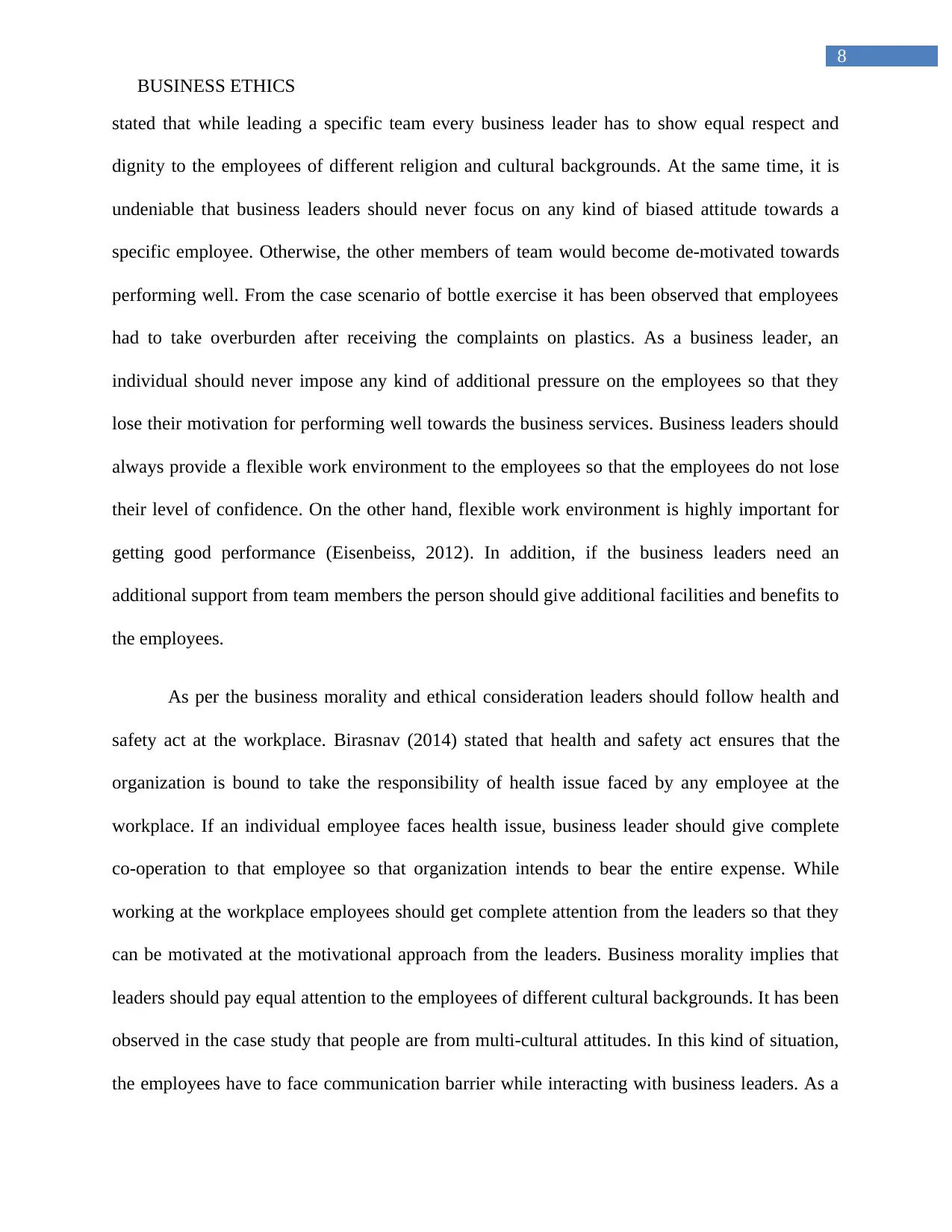
8
BUSINESS ETHICS
stated that while leading a specific team every business leader has to show equal respect and
dignity to the employees of different religion and cultural backgrounds. At the same time, it is
undeniable that business leaders should never focus on any kind of biased attitude towards a
specific employee. Otherwise, the other members of team would become de-motivated towards
performing well. From the case scenario of bottle exercise it has been observed that employees
had to take overburden after receiving the complaints on plastics. As a business leader, an
individual should never impose any kind of additional pressure on the employees so that they
lose their motivation for performing well towards the business services. Business leaders should
always provide a flexible work environment to the employees so that the employees do not lose
their level of confidence. On the other hand, flexible work environment is highly important for
getting good performance (Eisenbeiss, 2012). In addition, if the business leaders need an
additional support from team members the person should give additional facilities and benefits to
the employees.
As per the business morality and ethical consideration leaders should follow health and
safety act at the workplace. Birasnav (2014) stated that health and safety act ensures that the
organization is bound to take the responsibility of health issue faced by any employee at the
workplace. If an individual employee faces health issue, business leader should give complete
co-operation to that employee so that organization intends to bear the entire expense. While
working at the workplace employees should get complete attention from the leaders so that they
can be motivated at the motivational approach from the leaders. Business morality implies that
leaders should pay equal attention to the employees of different cultural backgrounds. It has been
observed in the case study that people are from multi-cultural attitudes. In this kind of situation,
the employees have to face communication barrier while interacting with business leaders. As a
BUSINESS ETHICS
stated that while leading a specific team every business leader has to show equal respect and
dignity to the employees of different religion and cultural backgrounds. At the same time, it is
undeniable that business leaders should never focus on any kind of biased attitude towards a
specific employee. Otherwise, the other members of team would become de-motivated towards
performing well. From the case scenario of bottle exercise it has been observed that employees
had to take overburden after receiving the complaints on plastics. As a business leader, an
individual should never impose any kind of additional pressure on the employees so that they
lose their motivation for performing well towards the business services. Business leaders should
always provide a flexible work environment to the employees so that the employees do not lose
their level of confidence. On the other hand, flexible work environment is highly important for
getting good performance (Eisenbeiss, 2012). In addition, if the business leaders need an
additional support from team members the person should give additional facilities and benefits to
the employees.
As per the business morality and ethical consideration leaders should follow health and
safety act at the workplace. Birasnav (2014) stated that health and safety act ensures that the
organization is bound to take the responsibility of health issue faced by any employee at the
workplace. If an individual employee faces health issue, business leader should give complete
co-operation to that employee so that organization intends to bear the entire expense. While
working at the workplace employees should get complete attention from the leaders so that they
can be motivated at the motivational approach from the leaders. Business morality implies that
leaders should pay equal attention to the employees of different cultural backgrounds. It has been
observed in the case study that people are from multi-cultural attitudes. In this kind of situation,
the employees have to face communication barrier while interacting with business leaders. As a
⊘ This is a preview!⊘
Do you want full access?
Subscribe today to unlock all pages.

Trusted by 1+ million students worldwide
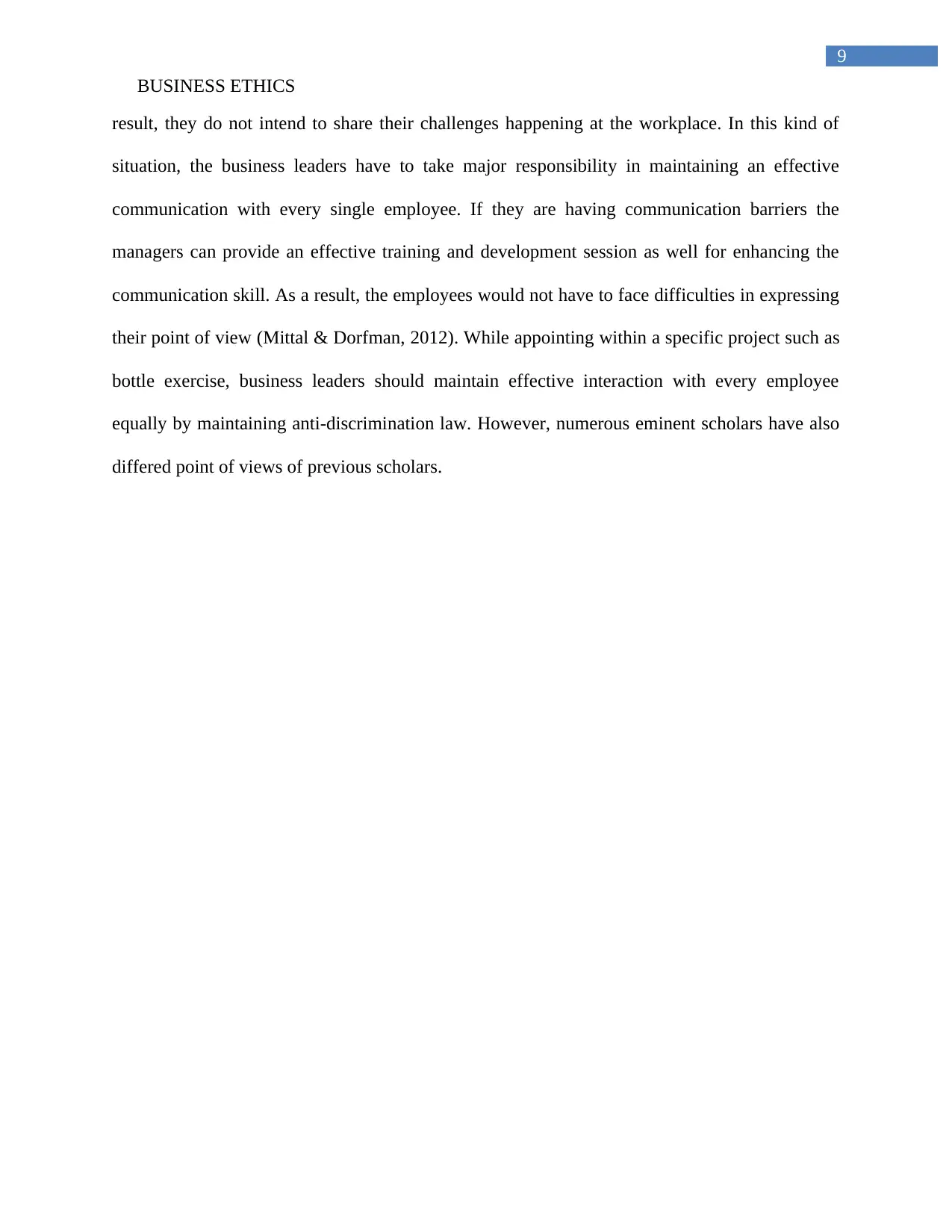
9
BUSINESS ETHICS
result, they do not intend to share their challenges happening at the workplace. In this kind of
situation, the business leaders have to take major responsibility in maintaining an effective
communication with every single employee. If they are having communication barriers the
managers can provide an effective training and development session as well for enhancing the
communication skill. As a result, the employees would not have to face difficulties in expressing
their point of view (Mittal & Dorfman, 2012). While appointing within a specific project such as
bottle exercise, business leaders should maintain effective interaction with every employee
equally by maintaining anti-discrimination law. However, numerous eminent scholars have also
differed point of views of previous scholars.
BUSINESS ETHICS
result, they do not intend to share their challenges happening at the workplace. In this kind of
situation, the business leaders have to take major responsibility in maintaining an effective
communication with every single employee. If they are having communication barriers the
managers can provide an effective training and development session as well for enhancing the
communication skill. As a result, the employees would not have to face difficulties in expressing
their point of view (Mittal & Dorfman, 2012). While appointing within a specific project such as
bottle exercise, business leaders should maintain effective interaction with every employee
equally by maintaining anti-discrimination law. However, numerous eminent scholars have also
differed point of views of previous scholars.
Paraphrase This Document
Need a fresh take? Get an instant paraphrase of this document with our AI Paraphraser
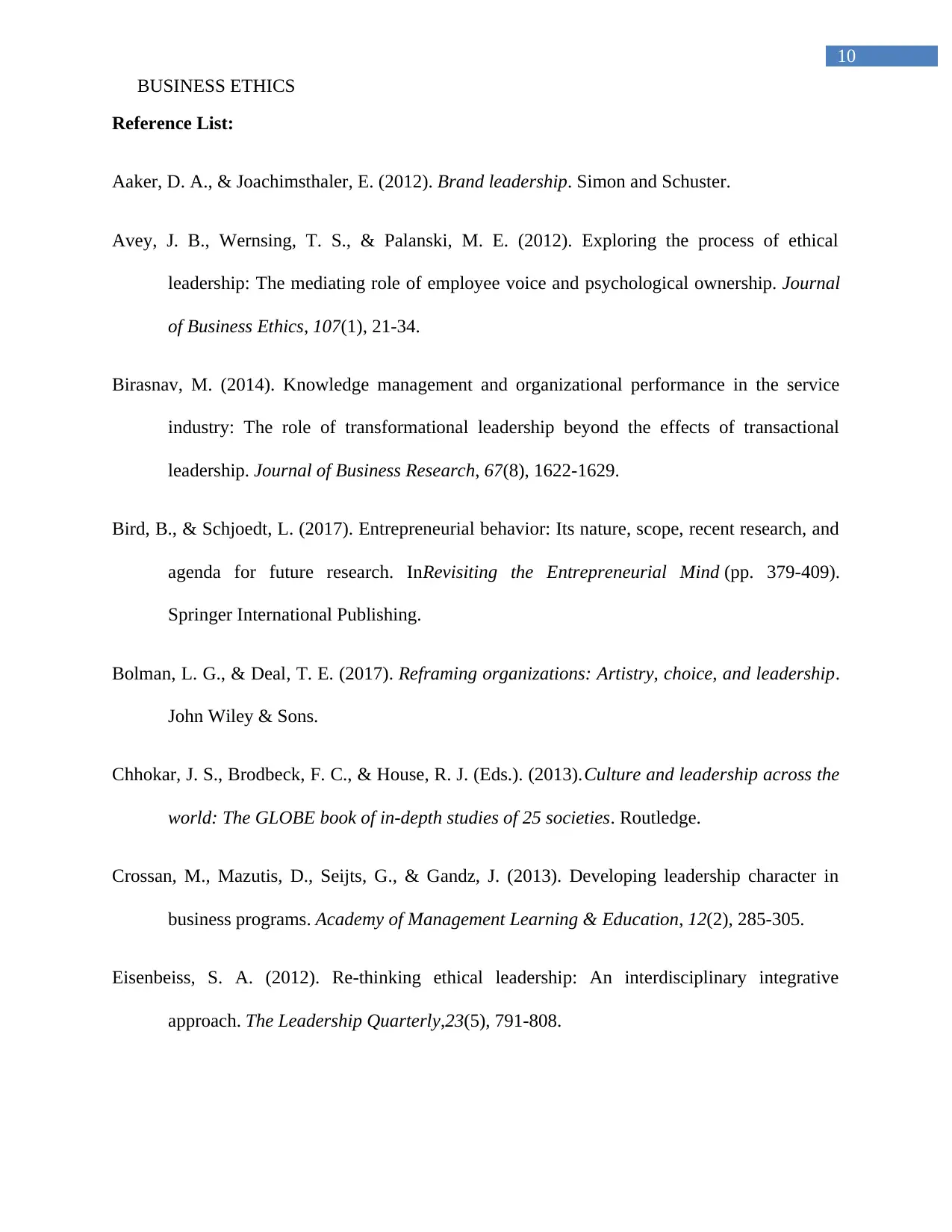
10
BUSINESS ETHICS
Reference List:
Aaker, D. A., & Joachimsthaler, E. (2012). Brand leadership. Simon and Schuster.
Avey, J. B., Wernsing, T. S., & Palanski, M. E. (2012). Exploring the process of ethical
leadership: The mediating role of employee voice and psychological ownership. Journal
of Business Ethics, 107(1), 21-34.
Birasnav, M. (2014). Knowledge management and organizational performance in the service
industry: The role of transformational leadership beyond the effects of transactional
leadership. Journal of Business Research, 67(8), 1622-1629.
Bird, B., & Schjoedt, L. (2017). Entrepreneurial behavior: Its nature, scope, recent research, and
agenda for future research. InRevisiting the Entrepreneurial Mind (pp. 379-409).
Springer International Publishing.
Bolman, L. G., & Deal, T. E. (2017). Reframing organizations: Artistry, choice, and leadership.
John Wiley & Sons.
Chhokar, J. S., Brodbeck, F. C., & House, R. J. (Eds.). (2013).Culture and leadership across the
world: The GLOBE book of in-depth studies of 25 societies. Routledge.
Crossan, M., Mazutis, D., Seijts, G., & Gandz, J. (2013). Developing leadership character in
business programs. Academy of Management Learning & Education, 12(2), 285-305.
Eisenbeiss, S. A. (2012). Re-thinking ethical leadership: An interdisciplinary integrative
approach. The Leadership Quarterly,23(5), 791-808.
BUSINESS ETHICS
Reference List:
Aaker, D. A., & Joachimsthaler, E. (2012). Brand leadership. Simon and Schuster.
Avey, J. B., Wernsing, T. S., & Palanski, M. E. (2012). Exploring the process of ethical
leadership: The mediating role of employee voice and psychological ownership. Journal
of Business Ethics, 107(1), 21-34.
Birasnav, M. (2014). Knowledge management and organizational performance in the service
industry: The role of transformational leadership beyond the effects of transactional
leadership. Journal of Business Research, 67(8), 1622-1629.
Bird, B., & Schjoedt, L. (2017). Entrepreneurial behavior: Its nature, scope, recent research, and
agenda for future research. InRevisiting the Entrepreneurial Mind (pp. 379-409).
Springer International Publishing.
Bolman, L. G., & Deal, T. E. (2017). Reframing organizations: Artistry, choice, and leadership.
John Wiley & Sons.
Chhokar, J. S., Brodbeck, F. C., & House, R. J. (Eds.). (2013).Culture and leadership across the
world: The GLOBE book of in-depth studies of 25 societies. Routledge.
Crossan, M., Mazutis, D., Seijts, G., & Gandz, J. (2013). Developing leadership character in
business programs. Academy of Management Learning & Education, 12(2), 285-305.
Eisenbeiss, S. A. (2012). Re-thinking ethical leadership: An interdisciplinary integrative
approach. The Leadership Quarterly,23(5), 791-808.
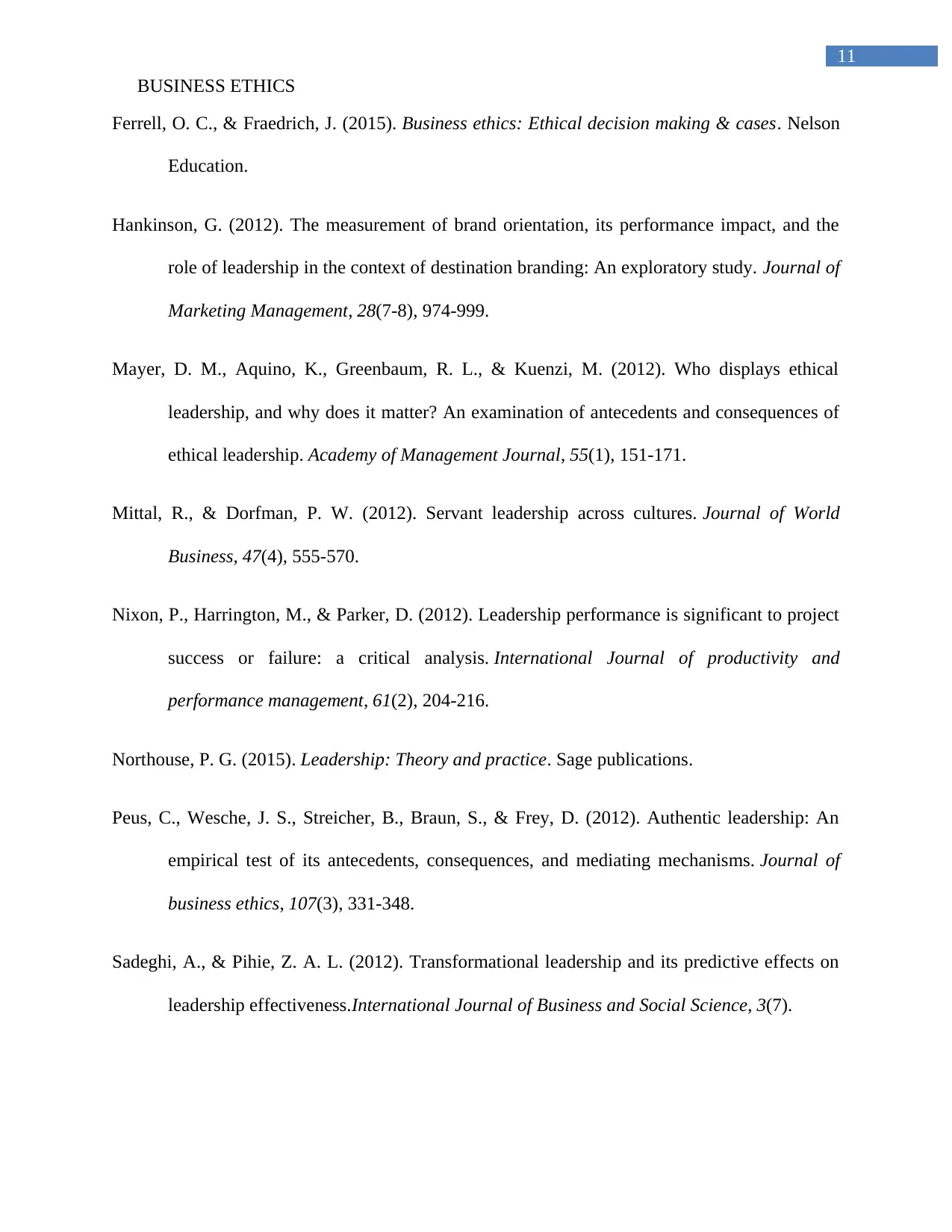
11
BUSINESS ETHICS
Ferrell, O. C., & Fraedrich, J. (2015). Business ethics: Ethical decision making & cases. Nelson
Education.
Hankinson, G. (2012). The measurement of brand orientation, its performance impact, and the
role of leadership in the context of destination branding: An exploratory study. Journal of
Marketing Management, 28(7-8), 974-999.
Mayer, D. M., Aquino, K., Greenbaum, R. L., & Kuenzi, M. (2012). Who displays ethical
leadership, and why does it matter? An examination of antecedents and consequences of
ethical leadership. Academy of Management Journal, 55(1), 151-171.
Mittal, R., & Dorfman, P. W. (2012). Servant leadership across cultures. Journal of World
Business, 47(4), 555-570.
Nixon, P., Harrington, M., & Parker, D. (2012). Leadership performance is significant to project
success or failure: a critical analysis. International Journal of productivity and
performance management, 61(2), 204-216.
Northouse, P. G. (2015). Leadership: Theory and practice. Sage publications.
Peus, C., Wesche, J. S., Streicher, B., Braun, S., & Frey, D. (2012). Authentic leadership: An
empirical test of its antecedents, consequences, and mediating mechanisms. Journal of
business ethics, 107(3), 331-348.
Sadeghi, A., & Pihie, Z. A. L. (2012). Transformational leadership and its predictive effects on
leadership effectiveness.International Journal of Business and Social Science, 3(7).
BUSINESS ETHICS
Ferrell, O. C., & Fraedrich, J. (2015). Business ethics: Ethical decision making & cases. Nelson
Education.
Hankinson, G. (2012). The measurement of brand orientation, its performance impact, and the
role of leadership in the context of destination branding: An exploratory study. Journal of
Marketing Management, 28(7-8), 974-999.
Mayer, D. M., Aquino, K., Greenbaum, R. L., & Kuenzi, M. (2012). Who displays ethical
leadership, and why does it matter? An examination of antecedents and consequences of
ethical leadership. Academy of Management Journal, 55(1), 151-171.
Mittal, R., & Dorfman, P. W. (2012). Servant leadership across cultures. Journal of World
Business, 47(4), 555-570.
Nixon, P., Harrington, M., & Parker, D. (2012). Leadership performance is significant to project
success or failure: a critical analysis. International Journal of productivity and
performance management, 61(2), 204-216.
Northouse, P. G. (2015). Leadership: Theory and practice. Sage publications.
Peus, C., Wesche, J. S., Streicher, B., Braun, S., & Frey, D. (2012). Authentic leadership: An
empirical test of its antecedents, consequences, and mediating mechanisms. Journal of
business ethics, 107(3), 331-348.
Sadeghi, A., & Pihie, Z. A. L. (2012). Transformational leadership and its predictive effects on
leadership effectiveness.International Journal of Business and Social Science, 3(7).
⊘ This is a preview!⊘
Do you want full access?
Subscribe today to unlock all pages.

Trusted by 1+ million students worldwide
1 out of 13
Related Documents
Your All-in-One AI-Powered Toolkit for Academic Success.
+13062052269
info@desklib.com
Available 24*7 on WhatsApp / Email
![[object Object]](/_next/static/media/star-bottom.7253800d.svg)
Unlock your academic potential
Copyright © 2020–2025 A2Z Services. All Rights Reserved. Developed and managed by ZUCOL.




